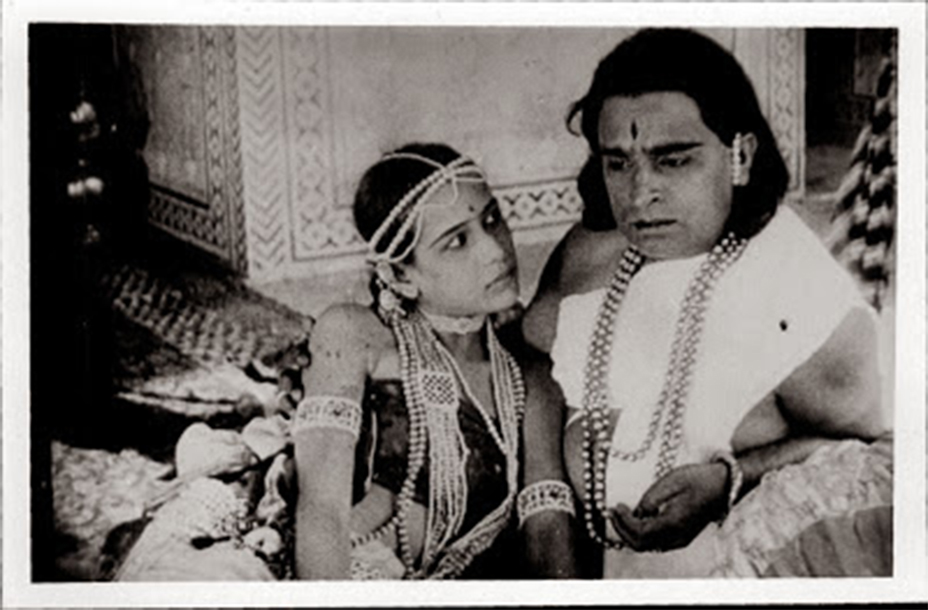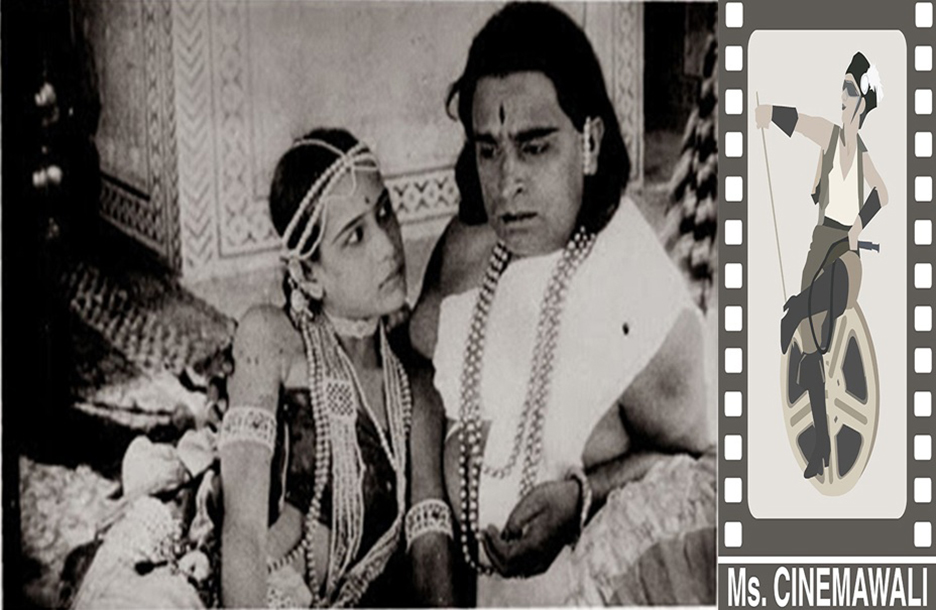About the column: This series presents short articles and photo-essays on the industrial aspects of cinema produced from Bombay aka Bollywood. Stories of the making of Bollywood, stars, publicity mechanisms, fan cultures, gossips, costumes, music usage, playback systems, singers, composers, as well as writings by the players and so on. The film industry, however, will be seen through the pointed glasses of women, intricately linking all the narratives of one ‘Miss Cinemawali’ or the other.
A story of deliberate amnesia, a powerful screen presence eclipsed by the bogey of respectability…The story of Sita Devi…
Let me begin the story of Sita Devi with her interview conducted by the ‘Indian Cinematograph Committee’(ICC) during 1927-28. Her original name was Miss Rainey Smith;however,she adopted the screen name Sita Devi and performed in landmark Indo-German productions namely PremSanyas/ The Light of Asia(1925), Shiraz(1928) and A Throw of Dice/Prapancha Pash(1929), and in many more films.[i]Franz Osten, of Acchut Kanya (1936) fame, directed all three films mentioned here; and the Indian actor-producer Himanshu Rai, who set up the famous Bombay Talkies in 1934, executed these films. Sita Devi, in her own admission, performed on stage before she joined films.
The following is an excerpt from Sita Devi’s interview (ICC Report, Vol. 4, pp- 894-897), which includes pointed questions pelted at her and at Patience Cooper,another well-known silent cinema actor.At that point in time, Sita Devi was working with Madan Theatres, Kolkata, which was an influential production-distribution company until the 1930s.
Questions [by the ICC]:Miss Sitadevi, how long have you been connected with this [acting]?
Sita Devi:For three years.
Q. [To Sita Devi and Patience Cooper]: Both of you like the job?
A. Yes.
Q. Both of you act on the stage?
A. No, only on the screen. [….]
Q.Do you think that Bengali [Hindu] girls are likely to take to this profession? [….]
A.Yes.
It is imperative to recall that in the early phase of Indian cinemas (especially those which were produced from Mumbai and Kolkata; and were circulated across North-West and Eastern territories), there were indeed few female actors who came from Bengali, Hindu and middle-class families. At least, the big stars of the period, particularly those who were interview by the ICC, had Euro-Asian lineage. The scene was thus, pulsating with a range of skilled formers, including Baijis (courtesans/public performers) and theatre actors, who introduced to Indian screen varied modes of action and bodily gestures. Both Neepa Majumdar and Kaushik Bhoumik have written about the stars of the period, and specifically about Sulochana nee Ruby Myers,and her iconic star value.[ii]
Furthermore, the subject of ‘respectable’ women and whether they should join films or not, i.e. the critical question of the so-called Bhadramohila and cinema, became a hot topic for debate.[iii] Nonetheless, during the 1930s, actor-directors like Dhirendra Nath Ganguli involved his wife Srimati Premlatika Devi (with the pseudo name Ramola Devi), while the eminent actor-director Modhu Bose along with the fabulous dancer Sadhana Bose (granddaughter of the reformist Keshab Chandra Sen) staged spectacular performances of Alibaba.[iv]Therefore, the styles of interrogation by the ICC, and the persistence of specific questions, become curiously engaging. For instance, ICC enquiries:
Q.I suppose you always work with Madans.[….]
A:No, the first picture I was in was The Light of Asia. That was my first picture. Later on I came to Madans.
Q. You are now with Madans?
A:Yes.
Q.There were other ladies in The Light of Asia. Do you know them at all?
A.Yes.
Q.Was it also their first time?
A.Yes.
Q.Now as regards the conditions of the studio life in this province [Bengal], are the conditions suitable for people like you going in to the trade? Are you treated well by the male actors?
A.Oh, yes.
Q. They are strangers; are you treated well?
A.Yes.
Q.You don’t experience any trouble or nuisance?
A.No.[….]
Q.You think the conditions are all right and the conditions are likely to attract good people to the screen. That is what we are anxious to know.
A. Oh, yes.[….]
Q.Why did you take on this [acting]?
A:It is very interesting.
 Sita Devi and the actor-producer Himanshu Rai in The Light of Asia
Sita Devi and the actor-producer Himanshu Rai in The Light of Asia
 Sita Devi as Gopa, Gautam Buddha’s wife
Sita Devi as Gopa, Gautam Buddha’s wife
 Face of a young star – all of thirteen
Face of a young star – all of thirteen
I have analyzed earlier how this telling ‘anxiousness’, as well, masculine conjectures and the subject of ‘respectability’ framed discussions on cinema. But, for now, let us focus on Miss Sita Devi. Her first film, The Light of Asia, is in reality an international production. Thus, a quick web search throws up a range of invaluable picture postcards, which label the film as an early German production, and consequently Sita Devi as an international star.[i]And, it is her (incomplete) story that throws an oblique light on thefunctioning of the film industry. For instance, the ICC further asks:
Q. Do you prefer Indian Companies?
A. There is no chance of going abroad or of joining any European companies [sic].
[….]
Q. How old were you when you first began to act?
A: 13. In The Light of Asia.
Q. And how did you get into it, did you answer an advertisement?
A. Yes.
Q. How were you chosen?
A. There were about 3,000 applicants. The Germans came out to produce The Light of Asia and they put in an advertisement.
Mr. Neogy [committee member]: How many months did it take to produce that picture?
A. Six months.
Chairman: Can you tell us of the 3,000 applications, how many were Bengalis or Anglo-Indians?
A. I heard from the Company that there were 3,000 applicants. I did not see them.
Q. Were you given an individual interview or did you appear with the others?
A. An individual interview. The Manager saw some of them every day.
As a matter of fact, Himanshu Rai (the producer of the film) in his interview to the same committee (Vol. 3, pp- 998- 1015) presents extensive information regarding the production of Indo-German films. More important, in this context, is his comment on Sita Devi.
Q. Yon were the Chief actor in The Light of Asia? In the part Buddha?
A. Yes.
Q. I suppose all the actors and actresses were Indians?
A. Yes, They were all recruited from India.
Q. One of them was Anglo-Indian?
A. Yes, The girl who took the leading part was an Anglo-Indian. She appeared as Sita Devi.
Q. That was the first time she assumed that name?
A. Yes.
Sir Haroon Jaffer [committee member]: Is she one of those we have seen?
A. Her name is Dyer. I believe.
Chairman: We have seen her.
Mr. Green[committee member]: That very young girl?
A. Yes.
Chairman: Who recruited the actresses?
A. I did.
Q. Are they fairly respectable people?
A. So far as I know all of them were respectable.
Besides the doggedness of the issue of ‘respectability’, it is apparent that Himanshu Rai, in fact, failed to remember the name of ‘that very young girl’ with whom he eventually made two more films (in 1928 and 29). In effect, one may propose that, Rai’s forgetfulness is our historical amnesia. Indeed, there are many actors, especially of the silent era, who have elapsed into a deep oblivion; while some, like Nadia/‘Hunterwali’ or Rai’s co-producer and actor wife Devika Rani, have been resurrected and reinvented as the shinning stars of the 1930s. In reality, only few actors from the 1920s, for ex. Sulochana (whose salary was seemingly larger than the salary of the Governor of Mumbai, and she who performed multiple/male roles in her films)endured the ‘Talkie’ period. Then again, Sita Devi, who also performed in Madans’ adaptations of Bankim Chandra Chattopadhyay’s classics, like Krishnakanter Will (1926), Durgesh Nandini (1927), Kapal Kundala (1929) etc., barely rings any bell.
It is only in the recent past that the British Film Institute has restored and released DVDs of the Indo-German productions with new background scores and even vocals.Truly, as one watches AThrow of Dice one has little doubt that Sita Devi was a ‘natural’ and had an electrifying screen presence. Nevertheless, one may reiterate that the voice of Sita Devi is effectively lost in the many passages of Silent cinema. One may therefore, conclude with a note of disquiet, and speculate how would we ever know what Sita Devi found ‘interesting’ about acting? Moreover, really how old was she when she started acting on stage, if she was only thirteen in The Light of Asia?
 The effervescent Sita Devi in AThrow of Dice
The effervescent Sita Devi in AThrow of Dice
 King Ranjit (Charu Roy) falls in love with the village girl
King Ranjit (Charu Roy) falls in love with the village girl
 One of the first kisses on ‘Indian’ screen
One of the first kisses on ‘Indian’ screen
 They plan to elope and get married
They plan to elope and get married
 But, Ranjit is falsely accused of murdering her father
But, Ranjit is falsely accused of murdering her father
 He also has one vice, which is addiction to dice
He also has one vice, which is addiction to dice
 Himanshu Rai (left) as the scheming villain, who is thrown off the cliff in the end
Himanshu Rai (left) as the scheming villain, who is thrown off the cliff in the end
_______________________________________________________________________________________________________________
[i] In several web resources she is also put as ‘Seeta Devi’.
[ii] See KaushikBhoumik (2005) ‘Sulochana: Clothes, Stardom and Gender in Early Indian Cinema’, Fashioning Film Stars, Dress, Culture, Identity, edited by Rachel Moseley, London: BFI Publishing: 88–97, and NeepaMajumdar’s (2010) seminal book Wanted Cultured Ladies Only!, Female Stardom and Cinema in India, 1930s-1950s, New Delhi: OUP.
[iii] Also see Madhuja Mukherjee (2014) ‘Of Bhadramohila, Blouses, and ‘Bustofine’: Re-viewing Bengali High Culture (1930s-40s) from a Low Angle’ in Popular and Visual Culture: Design, Circulation and Consumption, edited by Claria Sarmento and Ricardo Campos, Cambridge Scholars Publishing: Cambridge: 145-166.
[iv] For further discussions on the topic see Samik Bandhopadhyay, ed. (1993) Indian Cinema: Contemporary Perceptions from the Thirties, Jamshepur: Celluloid Chapter; and Madhuja Mukherjee ed. (forthcoming), Voices and Verses of the Talking Stars, The Women of Indian Cinema and Beyond, Stree: Calcutta.
[V] Check the following for an interesting textual commentary on Light of Asia: http://memsaabstory.com/2011/02/08/the-light-of-asia-1925/
















